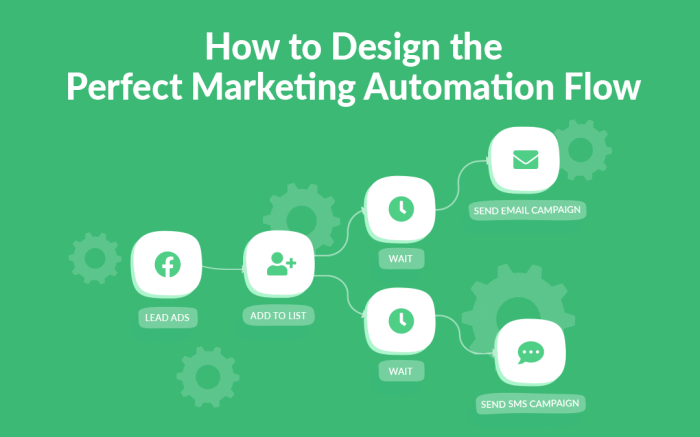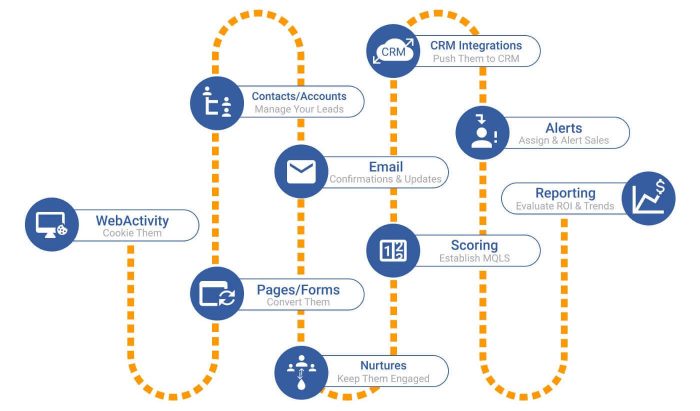Building a Marketing Automation Workflow kicks off the process of revolutionizing your marketing strategy by automating tasks and personalizing customer interactions. Get ready to dive into the world of efficient marketing campaigns!
Understanding Marketing Automation Workflow: Building A Marketing Automation Workflow

Marketing automation workflow refers to the process of automating marketing tasks and activities to streamline processes, increase efficiency, and drive personalized engagement with leads and customers. It involves the use of software and technology to automate repetitive marketing actions, such as sending emails, managing social media, and tracking customer interactions.
Benefits of Implementing a Marketing Automation Workflow
Implementing a marketing automation workflow offers several benefits, including:
- Improved efficiency: Automating repetitive tasks saves time and allows marketers to focus on more strategic initiatives.
- Enhanced lead nurturing: Automation helps deliver personalized content to leads at the right time, increasing conversion rates.
- Increased sales productivity: By automating lead scoring and qualification, sales teams can prioritize leads more effectively.
- Better tracking and reporting: Automation provides insights into customer behavior and campaign performance, enabling data-driven decision-making.
Tasks That Can Be Automated in a Marketing Workflow
Automation can be applied to various tasks in a marketing workflow, such as:
- Sending personalized emails based on user behavior and preferences.
- Lead scoring and segmentation to identify and prioritize high-quality leads.
- Social media scheduling and posting to engage with followers consistently.
- Automated follow-up sequences to nurture leads through the sales funnel.
Importance of Personalization in Marketing Automation Workflows
Personalization plays a crucial role in marketing automation workflows as it helps create tailored experiences for leads and customers. By leveraging data insights and automation tools, marketers can deliver relevant content, offers, and messages to specific segments of their audience. This personalized approach increases engagement, builds trust, and ultimately drives conversions.
Building Blocks of a Marketing Automation Workflow
In order to create an effective marketing automation workflow, it is important to understand the essential components that make up the process. Customer segmentation, triggers, and CRM integration play a crucial role in ensuring the workflow is successful.
Customer Segmentation
Customer segmentation involves dividing your target audience into smaller groups based on specific criteria such as demographics, behavior, or preferences. By segmenting your customers, you can create personalized and targeted campaigns that are more likely to resonate with each group.
- Segmenting customers based on their purchase history can help you tailor your messaging to their specific needs and interests.
- Behavioral segmentation allows you to target customers who have shown interest in a particular product or service, increasing the chances of conversion.
- Demographic segmentation helps you understand the characteristics of your audience, allowing you to create content that appeals to their specific demographics.
Triggers in the Workflow
Triggers are events or actions that initiate a response in the marketing automation workflow. These triggers can be based on a variety of factors such as customer behavior, time-based events, or interactions with your website or emails.
- Example of triggers include a customer signing up for a newsletter, making a purchase, or abandoning their shopping cart.
- Time-based triggers can be set up to send automated emails on a customer’s birthday or anniversary, increasing engagement and loyalty.
- Website triggers can be used to send targeted messages to customers based on their interactions with your site, encouraging them to take specific actions.
CRM Integration
Integrating your CRM system with your marketing automation workflow allows you to track and analyze customer interactions across multiple channels. This integration provides valuable insights into customer behavior and preferences, enabling you to create more personalized and effective campaigns.
- By integrating CRM data into your workflow, you can ensure that your messages are relevant and timely, increasing engagement and conversion rates.
- CRM integration also allows you to track the effectiveness of your campaigns and make data-driven decisions to optimize your marketing efforts.
- Automating the transfer of data between your CRM system and marketing automation platform streamlines the process and ensures that you have access to accurate and up-to-date customer information.
Designing a Marketing Automation Workflow
When it comes to designing a marketing automation workflow, there are several key steps to consider to ensure its effectiveness.
Mapping out a Workflow Based on Customer Journeys
One crucial aspect of designing a marketing automation workflow is mapping it out based on the customer journey. This involves understanding the different touchpoints a customer goes through before making a purchase decision.
- Identify key touchpoints: Map out the various interactions a customer has with your brand, from the awareness stage to post-purchase follow-ups.
- Create personalized content: Tailor your messaging and content to align with where the customer is in their journey, providing relevant information at each stage.
- Implement automation triggers: Set up triggers that automatically send messages or actions based on customer behavior, ensuring timely and targeted communication.
Setting Clear Goals and KPIs
Setting clear goals and key performance indicators (KPIs) is essential for measuring the success of your marketing automation workflow.
- Define objectives: Clearly Artikel what you aim to achieve with the workflow, whether it’s lead generation, nurturing, or increasing sales.
- Establish KPIs: Identify specific metrics to track, such as conversion rates, engagement levels, or revenue generated, to evaluate the workflow’s performance.
- Regularly monitor and analyze: Continuously review the data and insights gathered to optimize the workflow and make informed decisions.
Testing and Optimizing for Better Performance
Testing and optimizing your marketing automation workflow is crucial to ensure it delivers the desired results and remains effective over time.
- A/B testing: Experiment with different elements of the workflow, such as subject lines, content variations, or timing, to determine what resonates best with your audience.
- Analyze results: Evaluate the performance data from tests and identify areas for improvement or refinement to enhance the workflow’s effectiveness.
- Continuous optimization: Make iterative changes based on insights gained from testing and analysis to keep the workflow aligned with your goals and objectives.
Implementing and Monitoring a Marketing Automation Workflow

Implementing a marketing automation workflow involves setting up the automated processes and sequences that will guide leads through the marketing funnel. This includes creating email sequences, setting up triggers based on user behavior, and integrating various tools and platforms to streamline the workflow.
Role of A/B Testing in Optimizing Workflow Performance, Building a Marketing Automation Workflow
A/B testing plays a crucial role in optimizing workflow performance by allowing marketers to test different elements of their campaigns to see what resonates best with their audience. By testing variables such as subject lines, call-to-action buttons, and email content, marketers can gather valuable data to make informed decisions and improve the effectiveness of their workflows.
- Test different email subject lines to see which ones result in higher open rates.
- Experiment with different calls-to-action to determine which ones lead to more conversions.
- Adjust the timing and frequency of emails to find the optimal schedule for engagement.
Remember, A/B testing is an ongoing process that should be used to continuously refine and improve your marketing automation workflow.
Tools and Software for Monitoring and Analyzing Marketing Automation Workflows
There are several tools and software commonly used to monitor and analyze the effectiveness of marketing automation workflows, such as:
- Email marketing platforms like Mailchimp, HubSpot, and Marketo that offer analytics on open rates, click-through rates, and conversion rates.
- Customer relationship management (CRM) systems like Salesforce and Zoho CRM that track customer interactions and help identify potential leads.
- Marketing automation platforms like ActiveCampaign and Pardot that provide detailed insights into user behavior and engagement metrics.
Tips for Troubleshooting and Refining a Marketing Automation Workflow
When troubleshooting and refining a marketing automation workflow, consider the following tips:
- Regularly review and analyze the performance data to identify any bottlenecks or areas for improvement.
- Seek feedback from your sales and marketing teams to ensure alignment and identify any gaps in the workflow.
- Test different variations and strategies to see what works best for your audience and adjust accordingly.